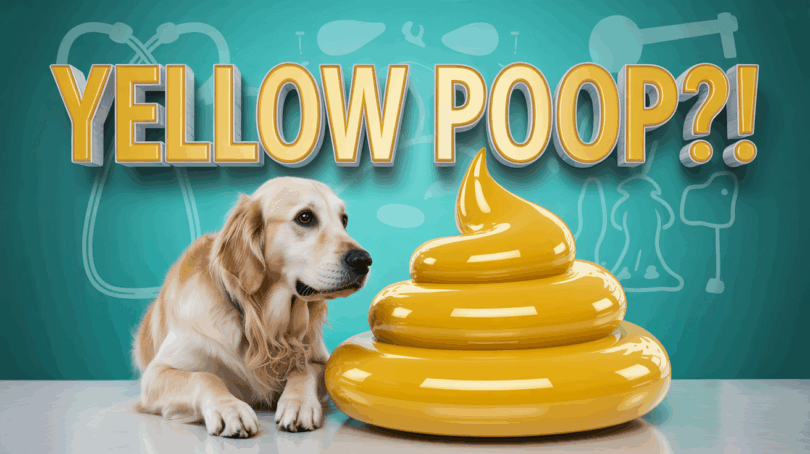Did you know 43% of pet owners overlook changes in their dog’s stool? While it might seem unpleasant, monitoring your furry friend’s waste is one of the easiest ways to catch digestive issues early. A healthy canine’s poop typically appears brown and firm, thanks to bile pigments and a balanced gut. But when that color shifts to yellow, it’s time to pay attention.
Sudden changes in stool shade often signal something’s off with your pet’s system. Dietary adjustments, infections, or even stress can alter digestion, leading to unusual hues. For example, rapid food transitions might overwhelm the stomach, while parasites could irritate the intestines. Though not always urgent, persistent yellow tones warrant a closer look.
This article breaks down why stool color matters, common triggers for shifts, and when to contact your vet. You’ll learn how everyday factors like treats or table scraps play a role, plus spot warning signs like diarrhea or lethargy. By understanding these clues, you’ll become better equipped to support your companion’s well-being.
Let’s explore what causes these changes, how to address them, and steps to keep your pet’s digestive tract thriving.
Understanding Normal Dog Poop and Digestive Health
Your dog’s stool offers a snapshot of their digestive health. Recognizing what’s typical helps you spot potential issues before they escalate. Let’s break down the basics every pet owner should know.
What Does Healthy Dog Poop Look Like?
Ideal stool is firm, moist, and chocolate-brown. It should hold its shape when picked up but crumble slightly under pressure. Uniform color indicates proper nutrient absorption. Occasional minor variations might occur after eating brightly colored veggies or treats with dyes.
The Role of Bile in Dog Digestion
Bile, produced by the liver, breaks down fats during digestion. This greenish fluid mixes with food in the small intestine. Most bile gets recycled, but leftover traces react with gut bacteria to create the brown pigment in stool. If digestion speeds up too much, bile isn’t fully processed—leading to color shifts.
Regular monitoring helps you catch changes early. Note texture, frequency, and hue during daily walks. Sudden shifts lasting over 24 hours? Contact your vet to rule out infections or dietary problems. A balanced diet supports consistent digestion and stool quality.
Yellow Bowel Movements in Dogs: Recognizing the Signs
How can you tell if your dog’s unusual stool color is a temporary glitch or a red flag? While single instances of odd hues might not raise alarms, patterns matter. Consistency in texture and shade often holds more clues than a one-off change.
Key Indicators That Demand Attention
A uniform mustard-like tone lasting multiple bowel movements suggests incomplete digestion. This could mean food isn’t breaking down properly, or bile flow is disrupted. Watch for accompanying issues like loose stools, excessive straining, or mucus coatings.
Behavior shifts matter too. If your pup seems lethargic, skips meals, or shows signs of abdominal discomfort, pair these observations with stool changes. Even subtle symptoms like increased thirst or weight loss deserve documentation.
Timeframe is critical. While a 12-hour episode after eating grass might resolve on its own, persistent alterations beyond a day warrant a vet visit. Bring notes about recent diet swaps, scavenged items, or travel history to help pinpoint causes faster.
Early action prevents complications. Digestive disturbances left unchecked can spiral into dehydration or nutrient deficiencies. Trust your instincts—if something feels off, professional guidance ensures your furry friend stays on track.
Common Causes Behind Yellow Dog Poop
When your furry companion’s stool changes color, it’s natural to wonder what’s happening inside their body. Yellow-toned waste often points to specific triggers affecting digestion. Let’s explore the two most frequent culprits and how they impact your pet’s system.
Dietary Changes and Food Intolerance
Switching foods too quickly overwhelms a dog’s stomach. New treats or table scraps can irritate sensitive guts, causing food to move faster through the intestines. This rapid transit prevents proper bile breakdown, leading to loose, yellowish stool.
Some pets struggle with specific ingredients like chicken, grains, or high-fat meals. Intolerances trigger inflammation, forcing the body to expel undigested food prematurely. Even healthy snacks like pumpkin might backfire if introduced suddenly.
Infections and Parasites as Contributing Factors
Giardia and other intestinal invaders disrupt nutrient absorption. These microscopic troublemakers damage the gut lining, creating pale or mustard-colored diarrhea. Roundworms and hookworms steal nutrients while irritating digestive tissues.
Pets with weakened immunity face higher risks. Watch for mucus in stool, vomiting, or sudden weight loss alongside color changes. A vet can perform fecal tests to identify hidden infections that diet adjustments alone won’t fix.
Tracking meal times and bathroom habits helps pinpoint causes. If issues persist beyond 48 hours despite bland diets, professional guidance ensures proper treatment. Early intervention prevents minor upsets from becoming chronic problems.
Environmental and Foreign Factors Affecting Poop Color
Dogs explore the world with their mouths, sometimes leading to unexpected discoveries in their stool. While diet plays a major role in digestive health, non-food items can also leave visible traces in your pet’s waste.
Accidental Ingestion of Yellow Substances
Curious pups often chew or swallow objects with bright pigments. Yellow crayons, rubber toys, or fabric fragments may pass through their system undigested. These materials can temporarily tint stool without causing lasting stomach issues.
Most cases resolve within 24-48 hours as the foreign material exits naturally. Watch for concerning symptoms like vomiting or loss of appetite alongside color changes. Secure small household items to prevent repeat incidents.
Pet-proofing becomes crucial for homes with accessible craft supplies or children’s toys. Store potential hazards in closed containers and supervise playtime with plush toys. If unusual coloration continues after removing suspect objects, schedule a vet visit to rule out blockages.
Quick action helps differentiate harmless incidents from serious problems. Document what your dog may have eaten and track bowel movement frequency. This information helps your vet determine if further tests are needed.
Treatment and Home Remedies for Yellow Dog Poop
When your dog’s stool takes on an unusual hue, immediate action paired with informed care makes all the difference. Mild cases often respond well to simple adjustments, while persistent symptoms require professional insight. Let’s explore strategies to restore digestive balance and when to escalate concerns.
Effective Home Care Tips to Support Digestive Health
Start by offering fresh water frequently. Dehydration worsens digestive issues, especially with loose stools. Replace meals with smaller portions of boiled chicken and plain rice—this bland combo soothes irritated stomachs.
Introduce probiotics designed for pets. These supplements repopulate healthy gut bacteria, aiding nutrient absorption. Pair this with a 12-hour fasting period (water only) to let the digestive tract reset.
Identifying When It’s Time to Consult Your Vet
Monitor improvements within 24-48 hours. If yellow-toned stool continues or worsens, schedule an exam. Watch for red flags like persistent vomiting, lethargy, or loss of appetite.
Vets might recommend fecal tests or blood work to check for parasites or liver problems. Chronic color changes could signal gallbladder issues or food allergies needing specialized diets. Timely visits prevent minor upsets from becoming severe health crises.
Preventive Care: Diet, Probiotics, and Routine Checkups
Preventing digestive problems starts long before unusual stool appears. A proactive approach to your pet’s health can minimize surprises and keep their system running smoothly. Simple daily habits build resilience against common triggers.
Building a Foundation for Gut Health
Selecting high-quality meals matters more than you might think. Look for formulas labeled for digestive support—these often contain prebiotics and easily digestible proteins. Avoid sudden food switches, which can shock sensitive stomachs.
Routine vet visits catch hidden problems early. Annual exams and fecal tests spot parasites or infections before they affect stool quality. Vaccinations also play a role by preventing illnesses that disrupt digestion.
Probiotics offer daily support for balanced gut flora. Studies show regular use improves nutrient absorption and reduces diarrhea episodes. Pair these supplements with fiber-rich foods to maintain consistent bowel movements.
Track meals and bathroom habits in a journal. Note treats, new foods, and any mucus in stool alongside behavior changes. This record helps identify patterns if issues arise later.
Small steps today create lasting wellness. By prioritizing prevention, you’ll spend less time worrying about odd poop colors and more time enjoying adventures together.
Addressing Medical Concerns Beyond the Poop Color
What if your dog’s unusual stool color hints at more than a passing issue? While monitoring waste provides clues, lasting changes often point to hidden conditions needing professional care. Observing patterns beyond bathroom habits helps separate minor upsets from systemic problems.
Understanding Underlying Health Issues
Persistent mustard-toned stool could signal liver trouble or pancreatic inflammation. These organs produce enzymes and bile critical for digestion—when compromised, they disrupt nutrient processing. Gallbladder blockages or infections may also alter pigment production, creating abnormal hues.
Watch for subtle shifts like reduced playfulness or reluctance to eat. A pet avoiding favorite activities or sleeping more than usual deserves attention. These behaviors paired with digestive changes often indicate deeper imbalances.
Monitoring Changes in Your Dog’s Behavior
Track energy fluctuations and appetite over 2-3 days. Sudden weight loss, excessive thirst, or vomiting alongside odd stool colors require urgent vet visits. Document episodes with timestamps and photos for clearer diagnosis.
Diagnostic tests like blood panels or ultrasounds uncover hidden conditions. Early detection of issues like biliary disease improves treatment outcomes. Your vet might recommend dietary adjustments or medications based on lab results.
Remember: Temporary color shifts happen, but consistency matters. Trust your observations—you know your companion best. Proactive care ensures small symptoms don’t escalate into major health battles.
Keeping Your Dog Happy: Wrapping Up Health Insights
Your companion’s digestive health tells a story worth understanding. Recognizing typical stool patterns helps spot early warnings—like unusual color shifts or texture changes. By staying alert to these signs, you become your pet’s first line of defense against hidden issues.
Common triggers for odd-colored waste range from abrupt food switches to intestinal invaders. Foreign objects or stress can also disrupt digestion. When simple adjustments like bland meals or probiotics don’t resolve concerns, vet guidance becomes essential.
Preventive care builds lasting wellness. Consistent nutrition, routine checkups, and tracking bathroom habits strengthen gut resilience. Most digestive challenges improve quickly with timely action and tailored care plans.
Remember: You’re not alone in navigating these moments. Armed with knowledge and a watchful eye, you can confidently support your furry friend’s health. Small daily efforts lead to big rewards—a thriving pet and peace of mind.
FAQ
What does healthy dog stool look like?
Normal canine feces should be chocolate brown, firm but not hard, and maintain consistent shape. Changes in color or texture often signal digestive shifts requiring attention.
Can new food cause yellow stool in dogs?
Yes, abrupt diet changes or fatty foods like chicken and rice may disrupt digestion. Gradually transition foods over 7-10 days and avoid table scraps to prevent color changes.
How do parasites affect stool color?
Intestinal parasites like giardia damage the gut lining, speeding food transit and reducing bile processing. This can create yellowish diarrhea. Regular deworming and fecal tests help prevent infections.










Leave a Comment